Academic Communication: Motivation, Engagement, and Self-Efficacy
VerifiedAdded on 2021/05/31
|11
|2344
|51
Literature Review
AI Summary
This literature review examines the crucial role of motivation, engagement, and self-efficacy in academic communication and student success within higher education. The review synthesizes findings from peer-reviewed journal articles to provide a comprehensive understanding of intrinsic and extrinsic motivational factors, the components of student engagement (emotional, behavioral, and cognitive), and the impact of self-efficacy on academic performance. It highlights the importance of teachers in fostering a supportive and flexible learning environment to enhance student engagement and motivation. The study also addresses the influence of socio-economic factors and cultural backgrounds on student motivation and self-efficacy, emphasizing the need for educators to identify and nurture individual student capabilities. The conclusion underscores the interconnectedness of engagement, motivation, self-efficacy, and effective communication in achieving academic goals, advocating for strategies that promote student success in higher education.
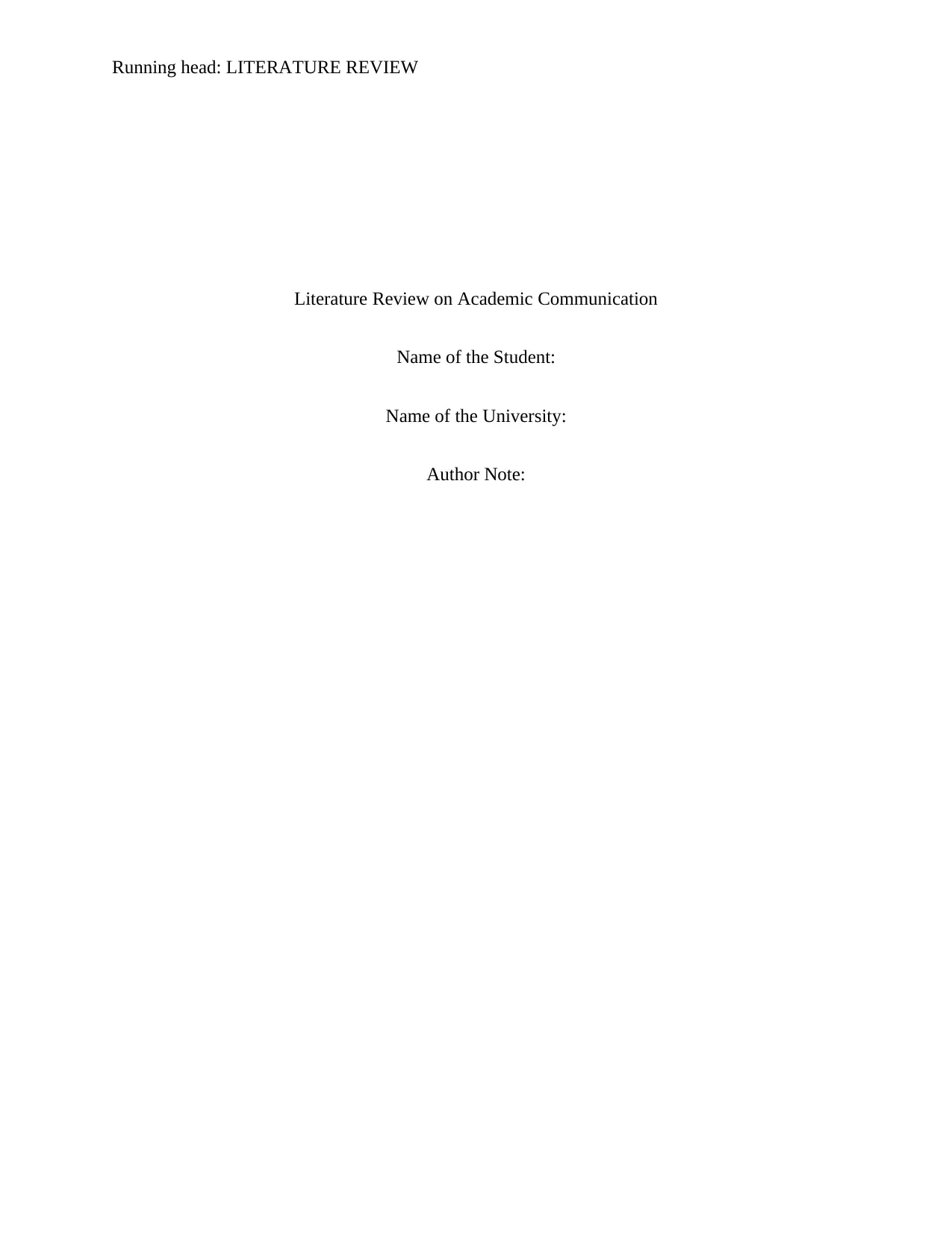
Running head: LITERATURE REVIEW
Literature Review on Academic Communication
Name of the Student:
Name of the University:
Author Note:
Literature Review on Academic Communication
Name of the Student:
Name of the University:
Author Note:
Paraphrase This Document
Need a fresh take? Get an instant paraphrase of this document with our AI Paraphraser
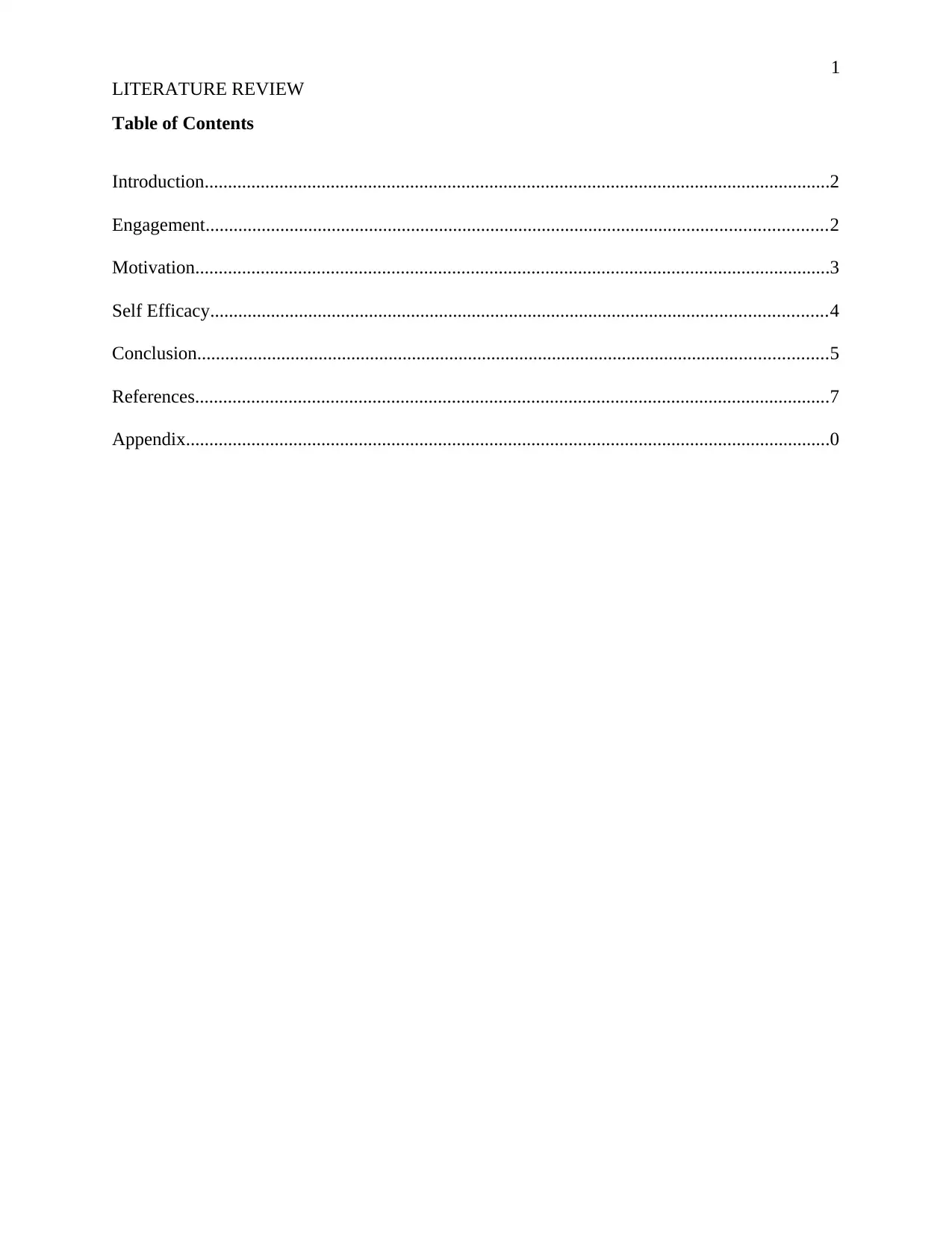
1
LITERATURE REVIEW
Table of Contents
Introduction......................................................................................................................................2
Engagement.....................................................................................................................................2
Motivation........................................................................................................................................3
Self Efficacy....................................................................................................................................4
Conclusion.......................................................................................................................................5
References........................................................................................................................................7
Appendix..........................................................................................................................................0
LITERATURE REVIEW
Table of Contents
Introduction......................................................................................................................................2
Engagement.....................................................................................................................................2
Motivation........................................................................................................................................3
Self Efficacy....................................................................................................................................4
Conclusion.......................................................................................................................................5
References........................................................................................................................................7
Appendix..........................................................................................................................................0
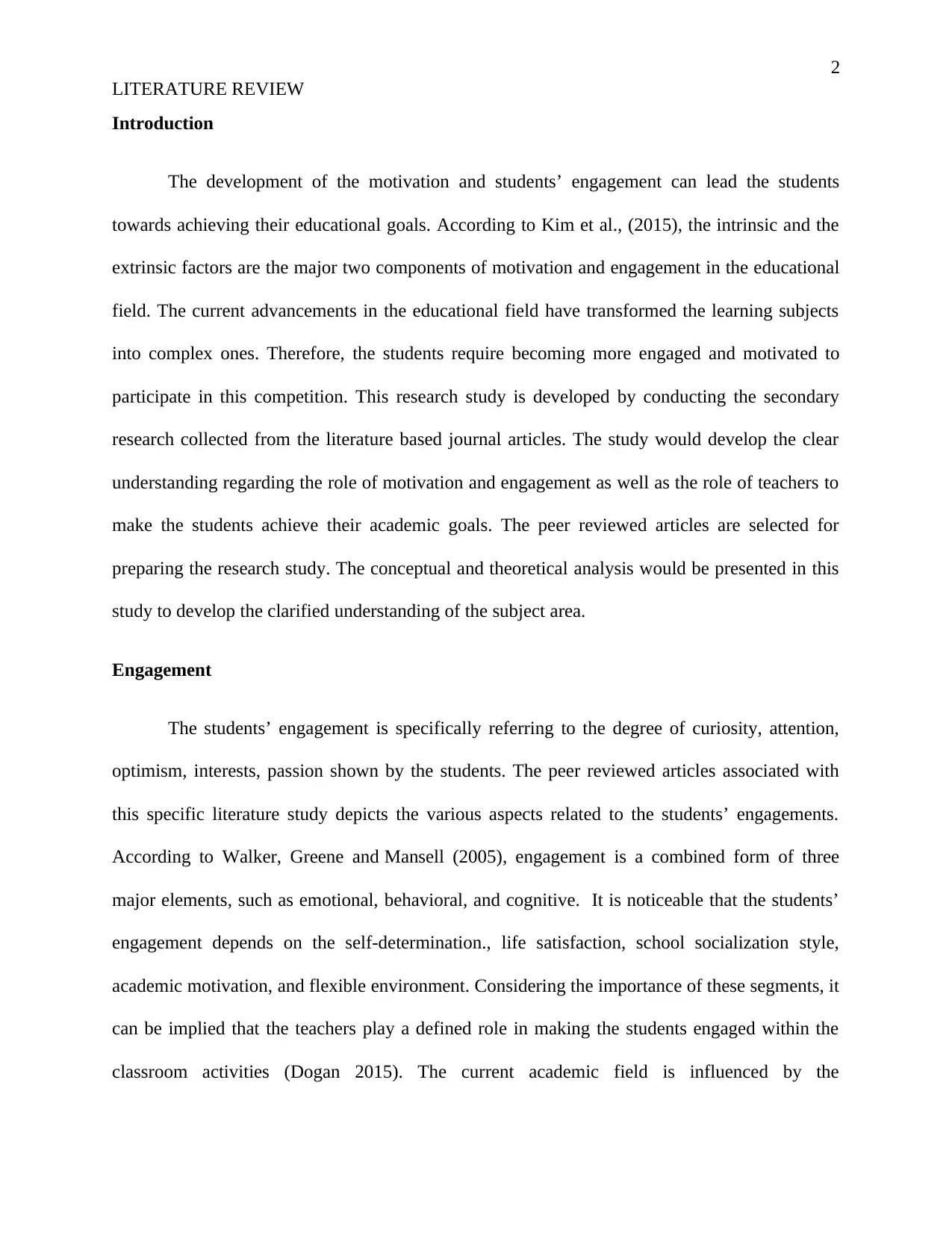
2
LITERATURE REVIEW
Introduction
The development of the motivation and students’ engagement can lead the students
towards achieving their educational goals. According to Kim et al., (2015), the intrinsic and the
extrinsic factors are the major two components of motivation and engagement in the educational
field. The current advancements in the educational field have transformed the learning subjects
into complex ones. Therefore, the students require becoming more engaged and motivated to
participate in this competition. This research study is developed by conducting the secondary
research collected from the literature based journal articles. The study would develop the clear
understanding regarding the role of motivation and engagement as well as the role of teachers to
make the students achieve their academic goals. The peer reviewed articles are selected for
preparing the research study. The conceptual and theoretical analysis would be presented in this
study to develop the clarified understanding of the subject area.
Engagement
The students’ engagement is specifically referring to the degree of curiosity, attention,
optimism, interests, passion shown by the students. The peer reviewed articles associated with
this specific literature study depicts the various aspects related to the students’ engagements.
According to Walker, Greene and Mansell (2005), engagement is a combined form of three
major elements, such as emotional, behavioral, and cognitive. It is noticeable that the students’
engagement depends on the self-determination., life satisfaction, school socialization style,
academic motivation, and flexible environment. Considering the importance of these segments, it
can be implied that the teachers play a defined role in making the students engaged within the
classroom activities (Dogan 2015). The current academic field is influenced by the
LITERATURE REVIEW
Introduction
The development of the motivation and students’ engagement can lead the students
towards achieving their educational goals. According to Kim et al., (2015), the intrinsic and the
extrinsic factors are the major two components of motivation and engagement in the educational
field. The current advancements in the educational field have transformed the learning subjects
into complex ones. Therefore, the students require becoming more engaged and motivated to
participate in this competition. This research study is developed by conducting the secondary
research collected from the literature based journal articles. The study would develop the clear
understanding regarding the role of motivation and engagement as well as the role of teachers to
make the students achieve their academic goals. The peer reviewed articles are selected for
preparing the research study. The conceptual and theoretical analysis would be presented in this
study to develop the clarified understanding of the subject area.
Engagement
The students’ engagement is specifically referring to the degree of curiosity, attention,
optimism, interests, passion shown by the students. The peer reviewed articles associated with
this specific literature study depicts the various aspects related to the students’ engagements.
According to Walker, Greene and Mansell (2005), engagement is a combined form of three
major elements, such as emotional, behavioral, and cognitive. It is noticeable that the students’
engagement depends on the self-determination., life satisfaction, school socialization style,
academic motivation, and flexible environment. Considering the importance of these segments, it
can be implied that the teachers play a defined role in making the students engaged within the
classroom activities (Dogan 2015). The current academic field is influenced by the
⊘ This is a preview!⊘
Do you want full access?
Subscribe today to unlock all pages.

Trusted by 1+ million students worldwide
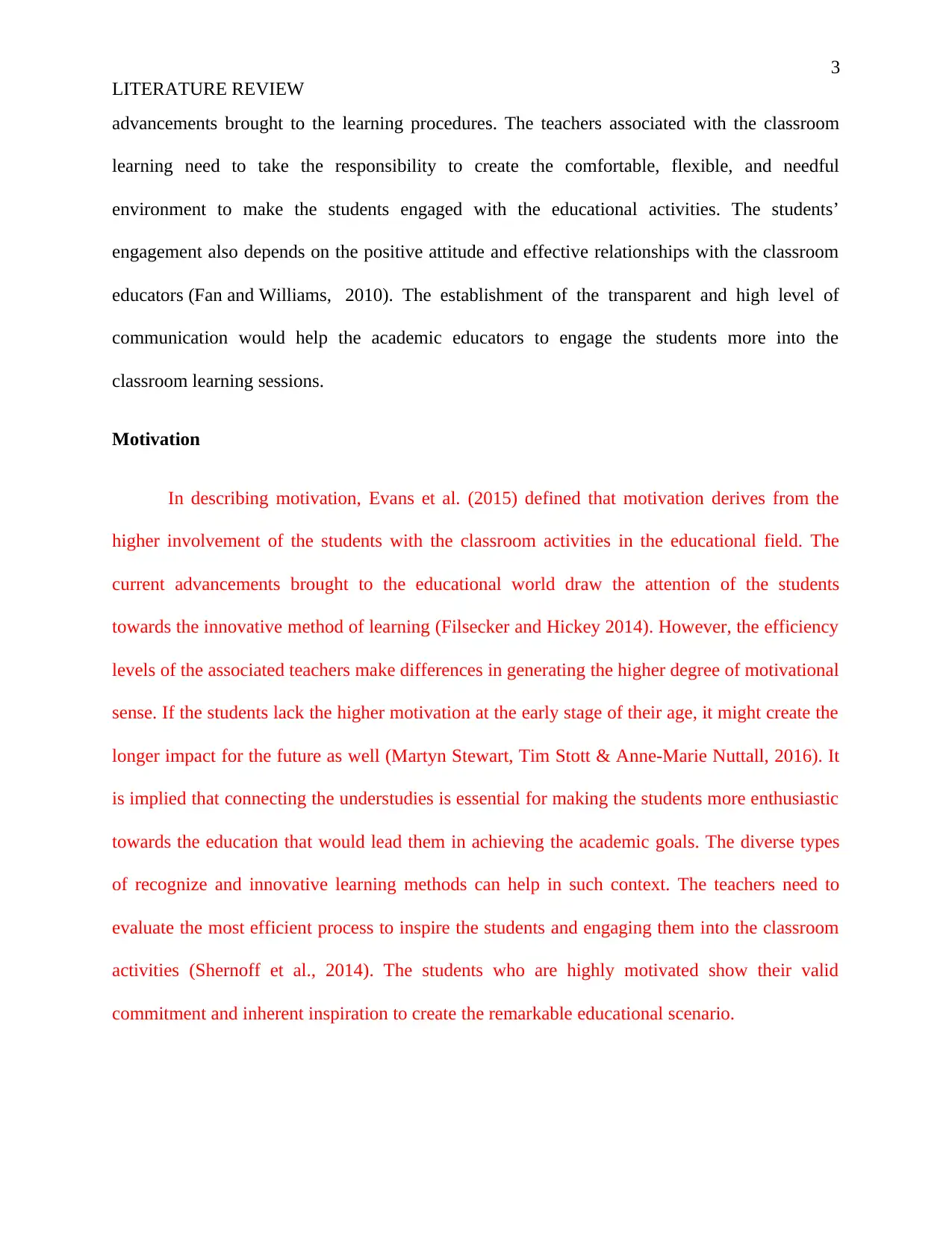
3
LITERATURE REVIEW
advancements brought to the learning procedures. The teachers associated with the classroom
learning need to take the responsibility to create the comfortable, flexible, and needful
environment to make the students engaged with the educational activities. The students’
engagement also depends on the positive attitude and effective relationships with the classroom
educators (Fan and Williams, 2010). The establishment of the transparent and high level of
communication would help the academic educators to engage the students more into the
classroom learning sessions.
Motivation
In describing motivation, Evans et al. (2015) defined that motivation derives from the
higher involvement of the students with the classroom activities in the educational field. The
current advancements brought to the educational world draw the attention of the students
towards the innovative method of learning (Filsecker and Hickey 2014). However, the efficiency
levels of the associated teachers make differences in generating the higher degree of motivational
sense. If the students lack the higher motivation at the early stage of their age, it might create the
longer impact for the future as well (Martyn Stewart, Tim Stott & Anne-Marie Nuttall, 2016). It
is implied that connecting the understudies is essential for making the students more enthusiastic
towards the education that would lead them in achieving the academic goals. The diverse types
of recognize and innovative learning methods can help in such context. The teachers need to
evaluate the most efficient process to inspire the students and engaging them into the classroom
activities (Shernoff et al., 2014). The students who are highly motivated show their valid
commitment and inherent inspiration to create the remarkable educational scenario.
LITERATURE REVIEW
advancements brought to the learning procedures. The teachers associated with the classroom
learning need to take the responsibility to create the comfortable, flexible, and needful
environment to make the students engaged with the educational activities. The students’
engagement also depends on the positive attitude and effective relationships with the classroom
educators (Fan and Williams, 2010). The establishment of the transparent and high level of
communication would help the academic educators to engage the students more into the
classroom learning sessions.
Motivation
In describing motivation, Evans et al. (2015) defined that motivation derives from the
higher involvement of the students with the classroom activities in the educational field. The
current advancements brought to the educational world draw the attention of the students
towards the innovative method of learning (Filsecker and Hickey 2014). However, the efficiency
levels of the associated teachers make differences in generating the higher degree of motivational
sense. If the students lack the higher motivation at the early stage of their age, it might create the
longer impact for the future as well (Martyn Stewart, Tim Stott & Anne-Marie Nuttall, 2016). It
is implied that connecting the understudies is essential for making the students more enthusiastic
towards the education that would lead them in achieving the academic goals. The diverse types
of recognize and innovative learning methods can help in such context. The teachers need to
evaluate the most efficient process to inspire the students and engaging them into the classroom
activities (Shernoff et al., 2014). The students who are highly motivated show their valid
commitment and inherent inspiration to create the remarkable educational scenario.
Paraphrase This Document
Need a fresh take? Get an instant paraphrase of this document with our AI Paraphraser
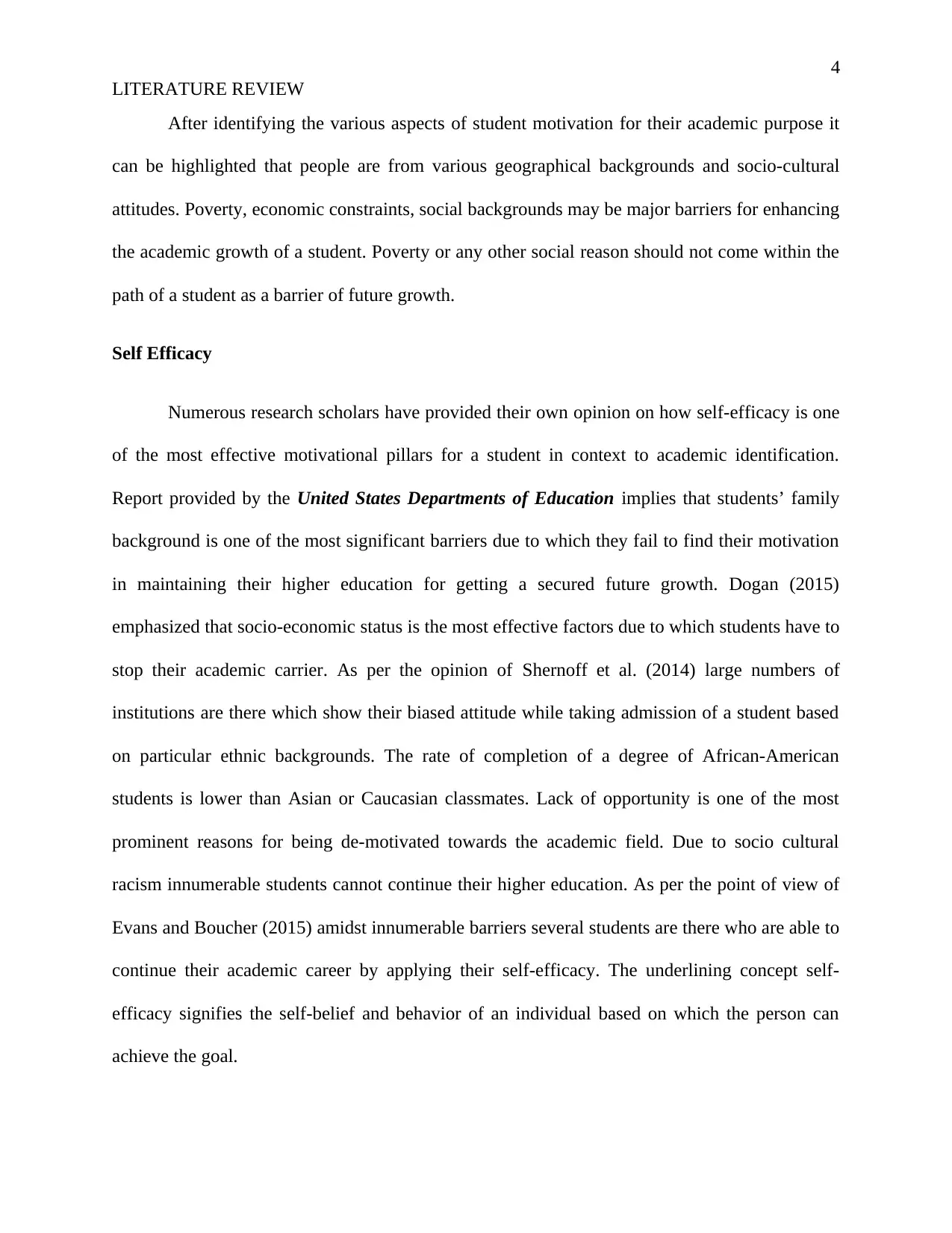
4
LITERATURE REVIEW
After identifying the various aspects of student motivation for their academic purpose it
can be highlighted that people are from various geographical backgrounds and socio-cultural
attitudes. Poverty, economic constraints, social backgrounds may be major barriers for enhancing
the academic growth of a student. Poverty or any other social reason should not come within the
path of a student as a barrier of future growth.
Self Efficacy
Numerous research scholars have provided their own opinion on how self-efficacy is one
of the most effective motivational pillars for a student in context to academic identification.
Report provided by the United States Departments of Education implies that students’ family
background is one of the most significant barriers due to which they fail to find their motivation
in maintaining their higher education for getting a secured future growth. Dogan (2015)
emphasized that socio-economic status is the most effective factors due to which students have to
stop their academic carrier. As per the opinion of Shernoff et al. (2014) large numbers of
institutions are there which show their biased attitude while taking admission of a student based
on particular ethnic backgrounds. The rate of completion of a degree of African-American
students is lower than Asian or Caucasian classmates. Lack of opportunity is one of the most
prominent reasons for being de-motivated towards the academic field. Due to socio cultural
racism innumerable students cannot continue their higher education. As per the point of view of
Evans and Boucher (2015) amidst innumerable barriers several students are there who are able to
continue their academic career by applying their self-efficacy. The underlining concept self-
efficacy signifies the self-belief and behavior of an individual based on which the person can
achieve the goal.
LITERATURE REVIEW
After identifying the various aspects of student motivation for their academic purpose it
can be highlighted that people are from various geographical backgrounds and socio-cultural
attitudes. Poverty, economic constraints, social backgrounds may be major barriers for enhancing
the academic growth of a student. Poverty or any other social reason should not come within the
path of a student as a barrier of future growth.
Self Efficacy
Numerous research scholars have provided their own opinion on how self-efficacy is one
of the most effective motivational pillars for a student in context to academic identification.
Report provided by the United States Departments of Education implies that students’ family
background is one of the most significant barriers due to which they fail to find their motivation
in maintaining their higher education for getting a secured future growth. Dogan (2015)
emphasized that socio-economic status is the most effective factors due to which students have to
stop their academic carrier. As per the opinion of Shernoff et al. (2014) large numbers of
institutions are there which show their biased attitude while taking admission of a student based
on particular ethnic backgrounds. The rate of completion of a degree of African-American
students is lower than Asian or Caucasian classmates. Lack of opportunity is one of the most
prominent reasons for being de-motivated towards the academic field. Due to socio cultural
racism innumerable students cannot continue their higher education. As per the point of view of
Evans and Boucher (2015) amidst innumerable barriers several students are there who are able to
continue their academic career by applying their self-efficacy. The underlining concept self-
efficacy signifies the self-belief and behavior of an individual based on which the person can
achieve the goal.
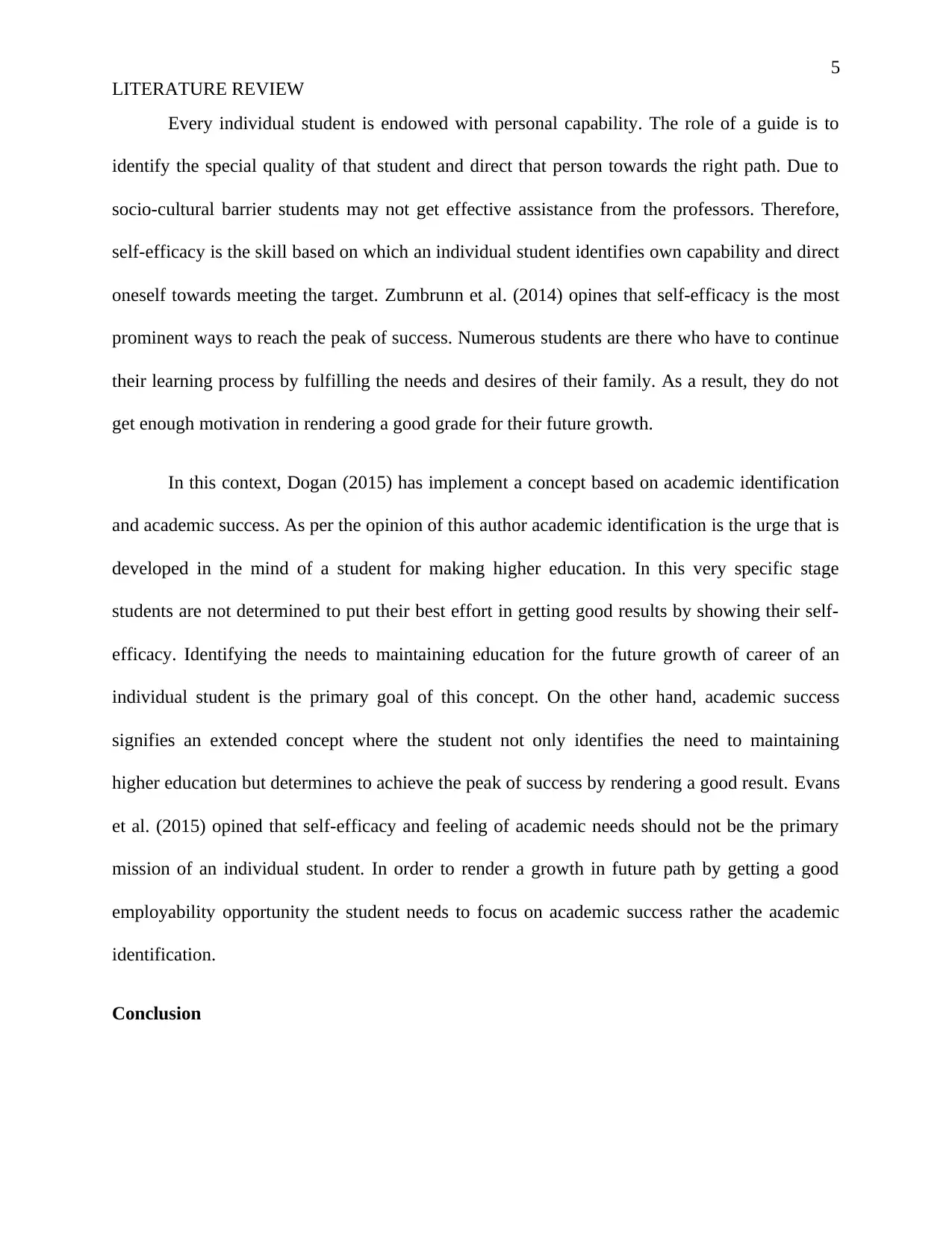
5
LITERATURE REVIEW
Every individual student is endowed with personal capability. The role of a guide is to
identify the special quality of that student and direct that person towards the right path. Due to
socio-cultural barrier students may not get effective assistance from the professors. Therefore,
self-efficacy is the skill based on which an individual student identifies own capability and direct
oneself towards meeting the target. Zumbrunn et al. (2014) opines that self-efficacy is the most
prominent ways to reach the peak of success. Numerous students are there who have to continue
their learning process by fulfilling the needs and desires of their family. As a result, they do not
get enough motivation in rendering a good grade for their future growth.
In this context, Dogan (2015) has implement a concept based on academic identification
and academic success. As per the opinion of this author academic identification is the urge that is
developed in the mind of a student for making higher education. In this very specific stage
students are not determined to put their best effort in getting good results by showing their self-
efficacy. Identifying the needs to maintaining education for the future growth of career of an
individual student is the primary goal of this concept. On the other hand, academic success
signifies an extended concept where the student not only identifies the need to maintaining
higher education but determines to achieve the peak of success by rendering a good result. Evans
et al. (2015) opined that self-efficacy and feeling of academic needs should not be the primary
mission of an individual student. In order to render a growth in future path by getting a good
employability opportunity the student needs to focus on academic success rather the academic
identification.
Conclusion
LITERATURE REVIEW
Every individual student is endowed with personal capability. The role of a guide is to
identify the special quality of that student and direct that person towards the right path. Due to
socio-cultural barrier students may not get effective assistance from the professors. Therefore,
self-efficacy is the skill based on which an individual student identifies own capability and direct
oneself towards meeting the target. Zumbrunn et al. (2014) opines that self-efficacy is the most
prominent ways to reach the peak of success. Numerous students are there who have to continue
their learning process by fulfilling the needs and desires of their family. As a result, they do not
get enough motivation in rendering a good grade for their future growth.
In this context, Dogan (2015) has implement a concept based on academic identification
and academic success. As per the opinion of this author academic identification is the urge that is
developed in the mind of a student for making higher education. In this very specific stage
students are not determined to put their best effort in getting good results by showing their self-
efficacy. Identifying the needs to maintaining education for the future growth of career of an
individual student is the primary goal of this concept. On the other hand, academic success
signifies an extended concept where the student not only identifies the need to maintaining
higher education but determines to achieve the peak of success by rendering a good result. Evans
et al. (2015) opined that self-efficacy and feeling of academic needs should not be the primary
mission of an individual student. In order to render a growth in future path by getting a good
employability opportunity the student needs to focus on academic success rather the academic
identification.
Conclusion
⊘ This is a preview!⊘
Do you want full access?
Subscribe today to unlock all pages.

Trusted by 1+ million students worldwide
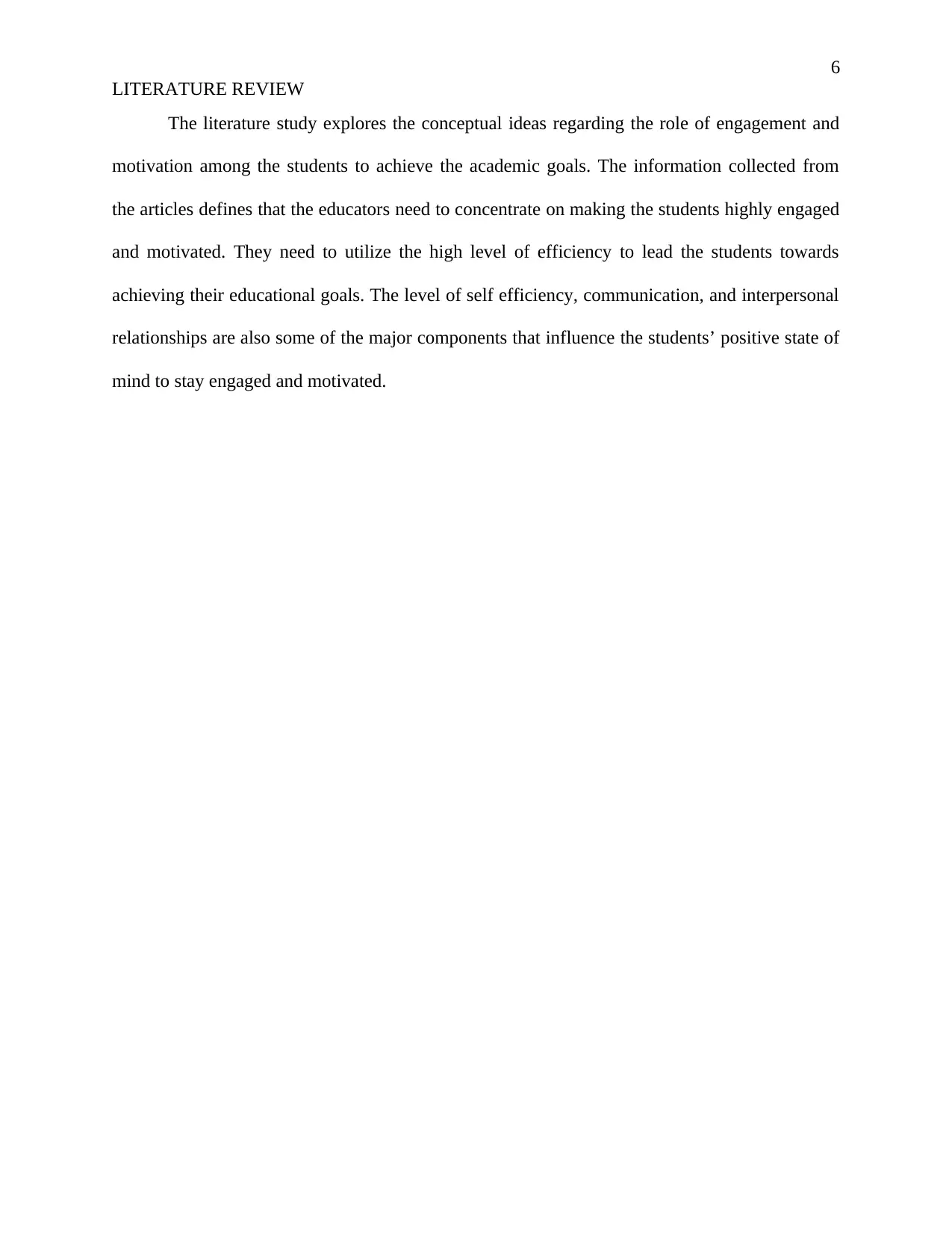
6
LITERATURE REVIEW
The literature study explores the conceptual ideas regarding the role of engagement and
motivation among the students to achieve the academic goals. The information collected from
the articles defines that the educators need to concentrate on making the students highly engaged
and motivated. They need to utilize the high level of efficiency to lead the students towards
achieving their educational goals. The level of self efficiency, communication, and interpersonal
relationships are also some of the major components that influence the students’ positive state of
mind to stay engaged and motivated.
LITERATURE REVIEW
The literature study explores the conceptual ideas regarding the role of engagement and
motivation among the students to achieve the academic goals. The information collected from
the articles defines that the educators need to concentrate on making the students highly engaged
and motivated. They need to utilize the high level of efficiency to lead the students towards
achieving their educational goals. The level of self efficiency, communication, and interpersonal
relationships are also some of the major components that influence the students’ positive state of
mind to stay engaged and motivated.
Paraphrase This Document
Need a fresh take? Get an instant paraphrase of this document with our AI Paraphraser
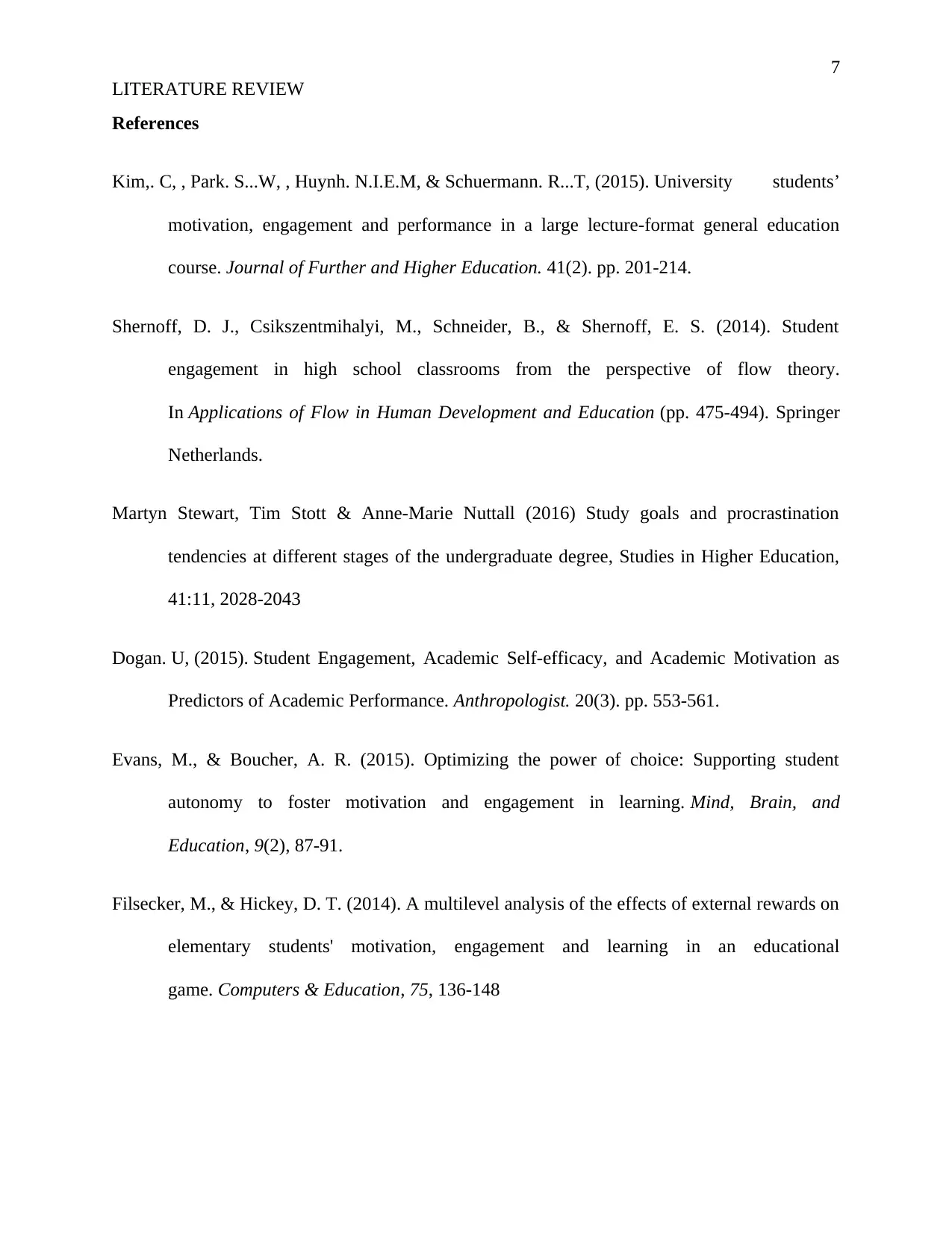
7
LITERATURE REVIEW
References
Kim,. C, , Park. S...W, , Huynh. N.I.E.M, & Schuermann. R...T, (2015). University students’
motivation, engagement and performance in a large lecture-format general education
course. Journal of Further and Higher Education. 41(2). pp. 201-214.
Shernoff, D. J., Csikszentmihalyi, M., Schneider, B., & Shernoff, E. S. (2014). Student
engagement in high school classrooms from the perspective of flow theory.
In Applications of Flow in Human Development and Education (pp. 475-494). Springer
Netherlands.
Martyn Stewart, Tim Stott & Anne-Marie Nuttall (2016) Study goals and procrastination
tendencies at different stages of the undergraduate degree, Studies in Higher Education,
41:11, 2028-2043
Dogan. U, (2015). Student Engagement, Academic Self-efficacy, and Academic Motivation as
Predictors of Academic Performance. Anthropologist. 20(3). pp. 553-561.
Evans, M., & Boucher, A. R. (2015). Optimizing the power of choice: Supporting student
autonomy to foster motivation and engagement in learning. Mind, Brain, and
Education, 9(2), 87-91.
Filsecker, M., & Hickey, D. T. (2014). A multilevel analysis of the effects of external rewards on
elementary students' motivation, engagement and learning in an educational
game. Computers & Education, 75, 136-148
LITERATURE REVIEW
References
Kim,. C, , Park. S...W, , Huynh. N.I.E.M, & Schuermann. R...T, (2015). University students’
motivation, engagement and performance in a large lecture-format general education
course. Journal of Further and Higher Education. 41(2). pp. 201-214.
Shernoff, D. J., Csikszentmihalyi, M., Schneider, B., & Shernoff, E. S. (2014). Student
engagement in high school classrooms from the perspective of flow theory.
In Applications of Flow in Human Development and Education (pp. 475-494). Springer
Netherlands.
Martyn Stewart, Tim Stott & Anne-Marie Nuttall (2016) Study goals and procrastination
tendencies at different stages of the undergraduate degree, Studies in Higher Education,
41:11, 2028-2043
Dogan. U, (2015). Student Engagement, Academic Self-efficacy, and Academic Motivation as
Predictors of Academic Performance. Anthropologist. 20(3). pp. 553-561.
Evans, M., & Boucher, A. R. (2015). Optimizing the power of choice: Supporting student
autonomy to foster motivation and engagement in learning. Mind, Brain, and
Education, 9(2), 87-91.
Filsecker, M., & Hickey, D. T. (2014). A multilevel analysis of the effects of external rewards on
elementary students' motivation, engagement and learning in an educational
game. Computers & Education, 75, 136-148
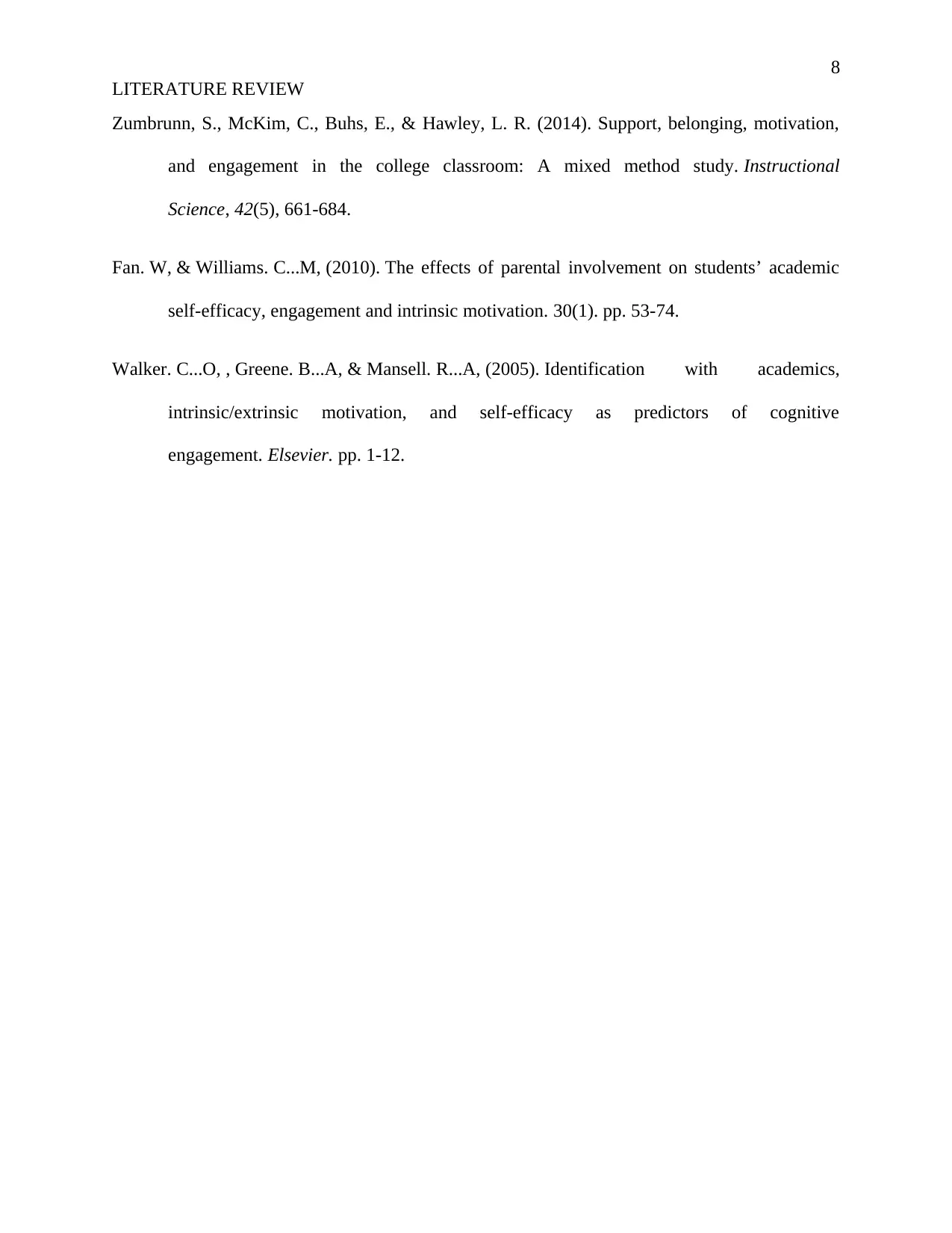
8
LITERATURE REVIEW
Zumbrunn, S., McKim, C., Buhs, E., & Hawley, L. R. (2014). Support, belonging, motivation,
and engagement in the college classroom: A mixed method study. Instructional
Science, 42(5), 661-684.
Fan. W, & Williams. C...M, (2010). The effects of parental involvement on students’ academic
self-efficacy, engagement and intrinsic motivation. 30(1). pp. 53-74.
Walker. C...O, , Greene. B...A, & Mansell. R...A, (2005). Identification with academics,
intrinsic/extrinsic motivation, and self-efficacy as predictors of cognitive
engagement. Elsevier. pp. 1-12.
LITERATURE REVIEW
Zumbrunn, S., McKim, C., Buhs, E., & Hawley, L. R. (2014). Support, belonging, motivation,
and engagement in the college classroom: A mixed method study. Instructional
Science, 42(5), 661-684.
Fan. W, & Williams. C...M, (2010). The effects of parental involvement on students’ academic
self-efficacy, engagement and intrinsic motivation. 30(1). pp. 53-74.
Walker. C...O, , Greene. B...A, & Mansell. R...A, (2005). Identification with academics,
intrinsic/extrinsic motivation, and self-efficacy as predictors of cognitive
engagement. Elsevier. pp. 1-12.
⊘ This is a preview!⊘
Do you want full access?
Subscribe today to unlock all pages.

Trusted by 1+ million students worldwide
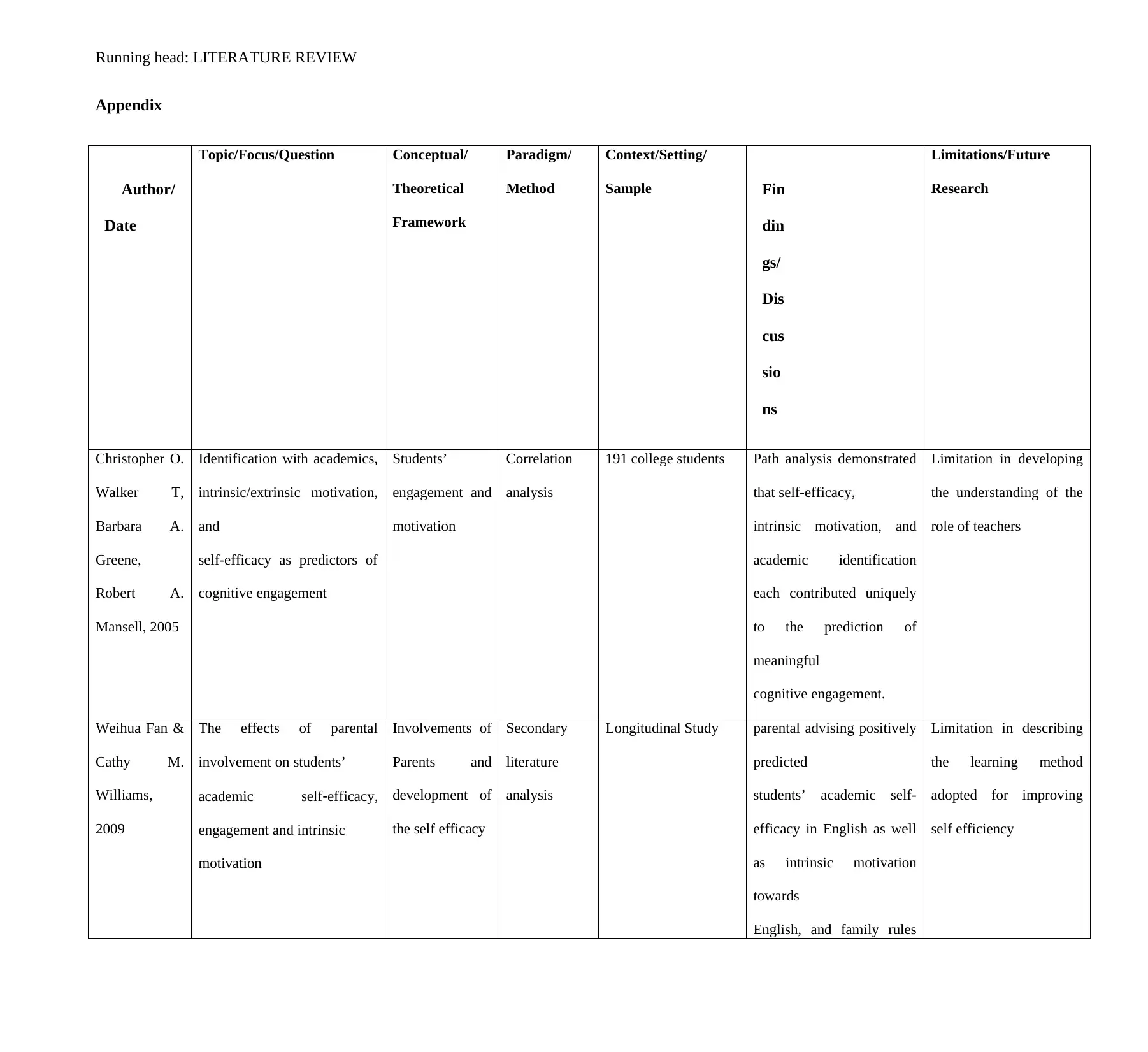
Running head: LITERATURE REVIEW
Appendix
Author/
Date
Topic/Focus/Question Conceptual/
Theoretical
Framework
Paradigm/
Method
Context/Setting/
Sample Fin
din
gs/
Dis
cus
sio
ns
Limitations/Future
Research
Christopher O.
Walker T,
Barbara A.
Greene,
Robert A.
Mansell, 2005
Identification with academics,
intrinsic/extrinsic motivation,
and
self-efficacy as predictors of
cognitive engagement
Students’
engagement and
motivation
Correlation
analysis
191 college students Path analysis demonstrated
that self-efficacy,
intrinsic motivation, and
academic identification
each contributed uniquely
to the prediction of
meaningful
cognitive engagement.
Limitation in developing
the understanding of the
role of teachers
Weihua Fan &
Cathy M.
Williams,
2009
The effects of parental
involvement on students’
academic self‐efficacy,
engagement and intrinsic
motivation
Involvements of
Parents and
development of
the self efficacy
Secondary
literature
analysis
Longitudinal Study parental advising positively
predicted
students’ academic self-
efficacy in English as well
as intrinsic motivation
towards
English, and family rules
Limitation in describing
the learning method
adopted for improving
self efficiency
Appendix
Author/
Date
Topic/Focus/Question Conceptual/
Theoretical
Framework
Paradigm/
Method
Context/Setting/
Sample Fin
din
gs/
Dis
cus
sio
ns
Limitations/Future
Research
Christopher O.
Walker T,
Barbara A.
Greene,
Robert A.
Mansell, 2005
Identification with academics,
intrinsic/extrinsic motivation,
and
self-efficacy as predictors of
cognitive engagement
Students’
engagement and
motivation
Correlation
analysis
191 college students Path analysis demonstrated
that self-efficacy,
intrinsic motivation, and
academic identification
each contributed uniquely
to the prediction of
meaningful
cognitive engagement.
Limitation in developing
the understanding of the
role of teachers
Weihua Fan &
Cathy M.
Williams,
2009
The effects of parental
involvement on students’
academic self‐efficacy,
engagement and intrinsic
motivation
Involvements of
Parents and
development of
the self efficacy
Secondary
literature
analysis
Longitudinal Study parental advising positively
predicted
students’ academic self-
efficacy in English as well
as intrinsic motivation
towards
English, and family rules
Limitation in describing
the learning method
adopted for improving
self efficiency
Paraphrase This Document
Need a fresh take? Get an instant paraphrase of this document with our AI Paraphraser
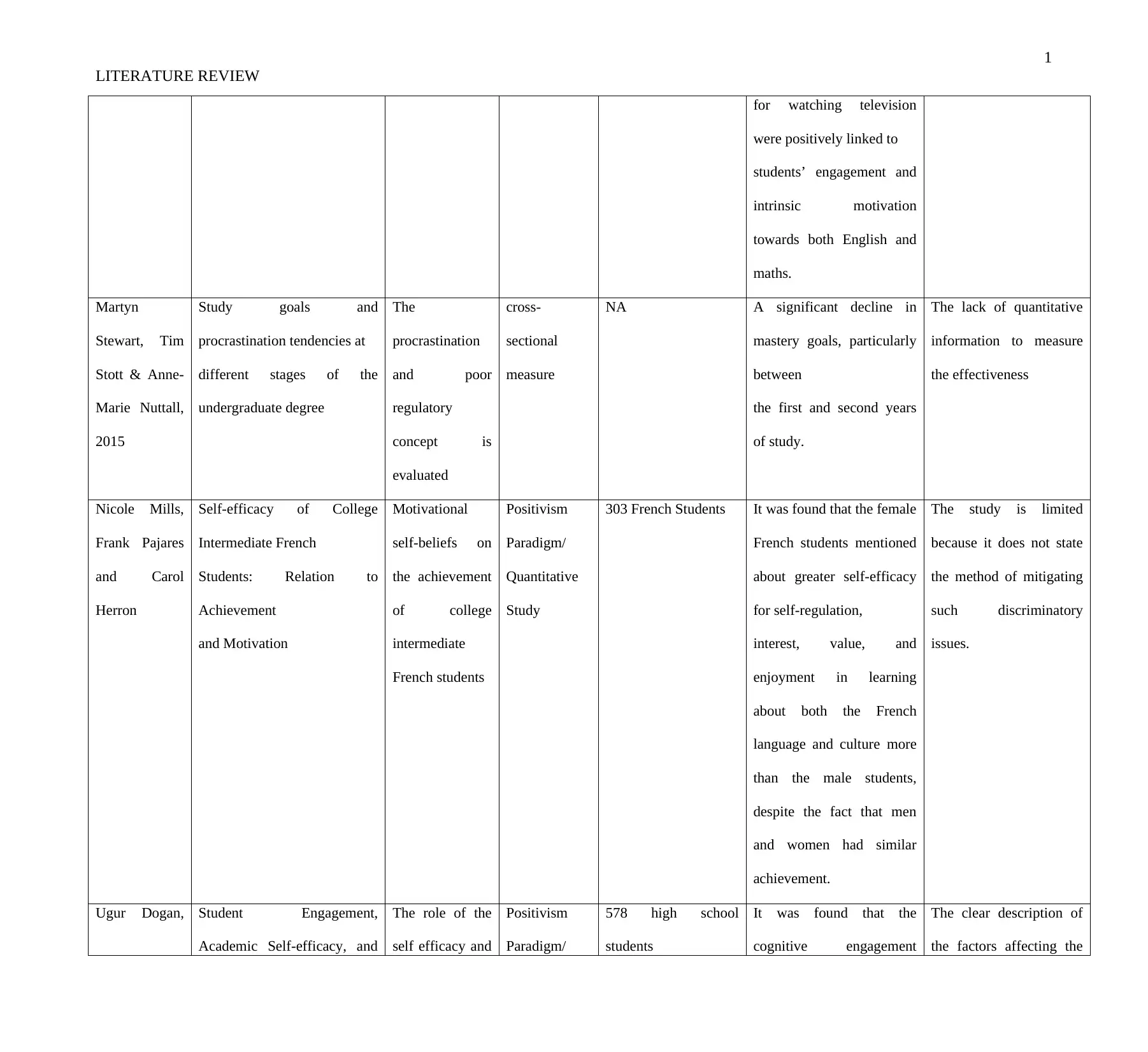
1
LITERATURE REVIEW
for watching television
were positively linked to
students’ engagement and
intrinsic motivation
towards both English and
maths.
Martyn
Stewart, Tim
Stott & Anne-
Marie Nuttall,
2015
Study goals and
procrastination tendencies at
different stages of the
undergraduate degree
The
procrastination
and poor
regulatory
concept is
evaluated
cross-
sectional
measure
NA A significant decline in
mastery goals, particularly
between
the first and second years
of study.
The lack of quantitative
information to measure
the effectiveness
Nicole Mills,
Frank Pajares
and Carol
Herron
Self-efficacy of College
Intermediate French
Students: Relation to
Achievement
and Motivation
Motivational
self-beliefs on
the achievement
of college
intermediate
French students
Positivism
Paradigm/
Quantitative
Study
303 French Students It was found that the female
French students mentioned
about greater self-efficacy
for self-regulation,
interest, value, and
enjoyment in learning
about both the French
language and culture more
than the male students,
despite the fact that men
and women had similar
achievement.
The study is limited
because it does not state
the method of mitigating
such discriminatory
issues.
Ugur Dogan, Student Engagement,
Academic Self-efficacy, and
The role of the
self efficacy and
Positivism
Paradigm/
578 high school
students
It was found that the
cognitive engagement
The clear description of
the factors affecting the
LITERATURE REVIEW
for watching television
were positively linked to
students’ engagement and
intrinsic motivation
towards both English and
maths.
Martyn
Stewart, Tim
Stott & Anne-
Marie Nuttall,
2015
Study goals and
procrastination tendencies at
different stages of the
undergraduate degree
The
procrastination
and poor
regulatory
concept is
evaluated
cross-
sectional
measure
NA A significant decline in
mastery goals, particularly
between
the first and second years
of study.
The lack of quantitative
information to measure
the effectiveness
Nicole Mills,
Frank Pajares
and Carol
Herron
Self-efficacy of College
Intermediate French
Students: Relation to
Achievement
and Motivation
Motivational
self-beliefs on
the achievement
of college
intermediate
French students
Positivism
Paradigm/
Quantitative
Study
303 French Students It was found that the female
French students mentioned
about greater self-efficacy
for self-regulation,
interest, value, and
enjoyment in learning
about both the French
language and culture more
than the male students,
despite the fact that men
and women had similar
achievement.
The study is limited
because it does not state
the method of mitigating
such discriminatory
issues.
Ugur Dogan, Student Engagement,
Academic Self-efficacy, and
The role of the
self efficacy and
Positivism
Paradigm/
578 high school
students
It was found that the
cognitive engagement
The clear description of
the factors affecting the
1 out of 11
Related Documents
Your All-in-One AI-Powered Toolkit for Academic Success.
+13062052269
info@desklib.com
Available 24*7 on WhatsApp / Email
![[object Object]](/_next/static/media/star-bottom.7253800d.svg)
Unlock your academic potential
Copyright © 2020–2025 A2Z Services. All Rights Reserved. Developed and managed by ZUCOL.





